
Presione Aqui
Dental Implants – Pacoima, CA
The Ultimate Answer
for Missing Teeth
While keeping your natural teeth is always ideal, dental implants are the next best thing. Like traditional bridges and dentures, they are used to replace teeth, but instead of just filling in the empty space that’s normally visible when you smile, they also act as a replacement for the roots that previously rested in the jawbone. In other words, dental implants don’t just look like real teeth; they feel and act like real teeth as well. To learn more about dental implants from our Pacoima, CA dentist and the new standard they’ve set for replacing teeth, call A New Smile today and set up a consultation with Dr. Ramtin.
Why Choose A New Smile for Dental Implants?
-
In-House Dental
Implant Placement -
Various Materials
for Implant Posts -
State-of-the-Art
Dental Technology
What are
Dental Implants?
A dental implant is a small post shaped like a screw. Traditionally, it is made out of titanium, but in recent years zirconia and ceramic implants have also become available. The post is designed to be surgically inserted into the jaw; as the mouth heals, the bone tissue will start to fuse with the post. Once this process (which is called osseointegration) is complete, the implant will be like a part of your body, and as a result your new restoration will enjoy unmatched stability once it has been attached.
The 4-Step Dental Implant Process

If you get dental implants, you’ll receive a multi-step treatment spanning a few months. However, you can rest easy – this time and effort are well worth the results. Since we place implants in-house, our dentists’ training and skills will benefit your procedure. As for the details, we’ll gladly share what you can expect from your treatment. The process will have four key steps: consultation, implant surgery, osseointegration, and delivery of your final restoration.
Initial Dental Implant Consultation
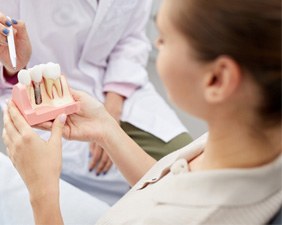
All dental implant work starts with a short consultation visit, where you’ll consult our dentists on what you want from treatment. This visit lets us learn more about your oral health, medical history, and similar factors. We can then use this information to see if implants suit you. We'll start drafting a custom treatment plan if we think they do.
That said, you needn’t worry if you don’t initially qualify for dental implants. You can become a good candidate later through preliminary services – gum disease therapy, tooth extractions, etc. By getting these treatments first, your mouth will be strong enough to support actual implants.
Of course, the consultation will also review the details of any future treatment(s). These include the procedure timeline, costs, etc.
Dental Implant Surgery
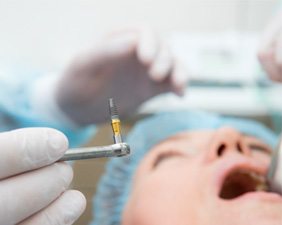
Since our office places dental implants in-house, we won’t refer you to outside specialists. That means you can skip the extra travel and have a faster surgery. Better yet, our dentists will already have your dental records if you're a returning patient.
The implant surgery itself will feature the following:
- Anesthesia – Before doing anything else, our surgeons will numb your treatment site. Doing so ensures you won’t feel pain from the surgery. Instead, you may feel a slight pressure as we operate.
- A Minor Incision – Once the anesthesia is applied, we’ll make a small incision in your gum tissue. This step will create a space for your future implant(s).
- Implant Placement – With the incision made, our surgeons will use advanced methods and tools to place your implant.
- Gum Closure – We’ll close your gum incision when the placement is finished. From there, we’ll place a cap over your new implant to wrap things up.
Dental Implant Osseointegration & Abutment
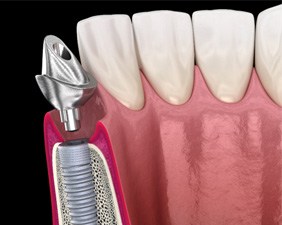
After the initial surgery, your new dental implant(s) will slowly fuse with your jaw. This process – also known as osseointegration – will occur over 4-6 months or so. Once it’s done, it’ll leave your implant post(s) permanent and secure.
When you’ve recovered from the implant fusion, you’ll have a follow-up surgery. This one will set an abutment (i.e., a metal connector) on your implant. The new part will secure your final restoration, which will be based on earlier dental impressions.
Delivery of Dental Implant Restoration(s)
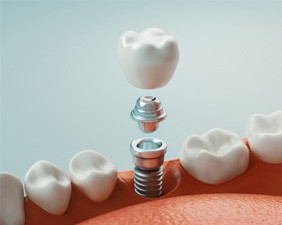
You’ll get your final restoration at the end of the implant process. Regarding specifics, what you receive will depend on how many teeth were lost. It could be a dental crown, bridge, or an implant denture.
It often doesn’t take long to fit this restoration. Really, adding it to your implant only requires a small application of dental cement. Our dental team can then make some last-minute changes to ensure optimal results. With that out of the way, you’ll be ready to enjoy your restored grin!
Benefits of Dental Implants

Dental implants are a unique restoration and offer several equally unique benefits. Whether you need one tooth replacement or multiple, they can fill out your smile and drastically enhance your oral function. Below, you’ll get a more detailed glimpse of what life will be like with dental implants. We think you’ll agree that overall, your quality of life will be much improved!
Day-to-Day Benefits

Since dental implants are embedded in your jawbone, they feel more like natural teeth than other replacement options. The implant itself doesn’t have any nerves, of course, but the surrounding gums and tissue will receive realistic feedback when you chew and bite. Plus, the implant posts will keep your replacement firmly in place. There won’t be any slippage while eating or talking!
Health Benefits

The stimulation that dental implants can provide to your oral structure creates another interesting advantage. Normally when you lose a tooth and replace it with a bridge or type or denture, that part of your jawbone will start to deteriorate. It’s not receiving feedback from a dental root system anymore, so your brain thinks it’s no longer needed!
With a dental implant replacement set in place, your jawbone will receive the stimulation it needs in order to preserve itself, sparing you from oral health complications down the road.
Long-Term Benefits

Dental implants are simple to take care of, which makes it easier to stay motivated to maintain them. Just by brushing your smile twice daily and flossing at least once per day, you can increase your implants’ longevity. On average they last about 15 years, but with dedicated care can stand the test of time for several decades. Imagine how fewer dental appointments you’ll need with a restoration that won’t need to be replaced for 30 years!
Last but certainly not least, a smile supported by dental implants is a smile you can confident about. Thanks to their stability and durability, you can count on them for your everyday needs, and thanks to their top-notch aesthetics, you won’t have to feel self-conscious about how your teeth look. In the long run, that kind of peace of mind is truly priceless!
Who Dental Implants Can Help

To get dental implants for your missing teeth, you need to have a fully grown jaw that still has a sufficient level of bone density to secure implants in place. Also, your mouth needs to be healthy and free of infection, and any autoimmune conditions, such as diabetes, that could affect bone healing needs to be under control. Note that even if you’re not currently a candidate for implants, you might still be able to get them after certain treatments are performed.
Missing Single Tooth
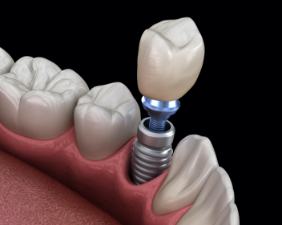
A single dental implant can be combined with a crown in order to replace one tooth. The crown will be designed to blend in with the surrounding teeth. Getting an implant instead of a traditional bridge means that we don’t have to alter any of your existing teeth to make room for the final restoration.
Missing Multiple Teeth
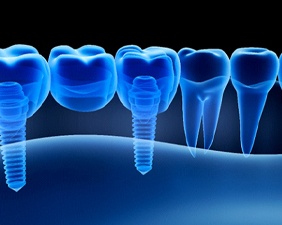
It’s possible to replace any number of teeth with dental implants, but you do not have to get an implant post and crown for each one. If three or more consecutive teeth have been lost, for instance, you can get a dental bridge that uses a pair of dental implants for support.
Missing All Teeth
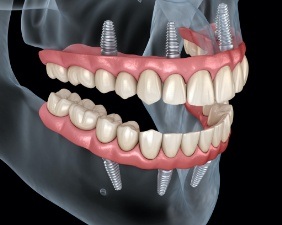
Should you have no natural teeth left, you may still be able to enjoy dental implants. We can use four to eight dental implants around your mouth to anchor a full implant denture into place. If you do not have enough jawbone density to support an implant denture and do not want to get a bone graft, we may recommend All-On-4 dental implants, which only require four dental implants to secure a full denture.
Understanding the Cost of Dental Implants

When considering the cost of dental implants, there are two things to keep in mind. The first is that the cost of the entire implant process is going to vary based on the number of implants you get and various other factors. The second is that despite the fact that dental implant restorations are more costly than traditional ones, they can actually end up being your best financial option due to their significantly longer lifespan minimizing the need for replacements.
Maintaining & Caring for Your Dental Implants

Dental implants are quite durable, and they have a very high success rate of 95%. However, that doesn’t mean that they can’t be damaged or fail under certain circumstances. If you want your dental implants to last for as long as possible, then you need to be able to take proper care of them. Below is a closer look at the basics of dental implant maintenance that you should keep in mind in order to protect your rebuilt smile.
Make Oral Hygiene a Priority
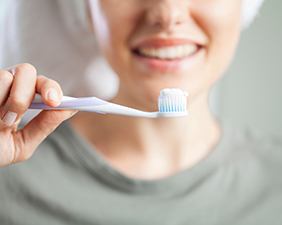
One of the most important things you can do to keep your dental implants safe is to maintain good oral health habits. Remember to brush at least two times a day, and be sure to pay close attention to the area around your implant posts. You should also make a point of flossing and rinsing with mouthwash regularly. These simple steps will go a long way toward protecting your mouth from gum disease, which happens to be a leading cause of dental implant failure.
Eat a Healthy Diet

You need to be mindful about the foods you eat and the impact they can have on your dental implants. Foods that are high in sugar and starch can increase your risk for gum disease, so they’re best enjoyed in moderation. Meanwhile, a balanced diet that includes plenty of fruits and vegetables will go a long way toward helping you maintain a healthy oral environment for your implant posts.
Break Bad Habits
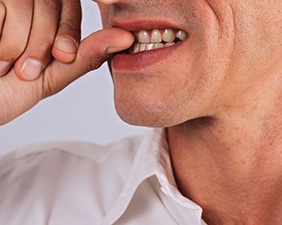
There are a number of bad habits that could be damaging your dental implants without you even realizing it. Do you routinely use your teeth to open stubborn packages? Do you often find yourself chewing your fingernails or the end of your pen? Do you sometimes crunch the ice at the bottom of the glass? These are all examples of habits that you should make a point of breaking if you don’t want to cause unnecessary problems for your dental implants.
Protect Your Dental Implants
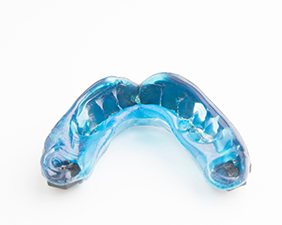
A sudden blow to your mouth could end up breaking your dental implants. Thus, to keep your rebuilt smile safe, you should always wear a mouthguard while playing any kind of sport – especially contact sports such as football.
Additionally, if you grind or clench your teeth at night, you should make sure that your dental implants are protected from damage. You can do so by wearing a personalized nightguard.
Schedule Regular Dental Checkups

Just like your natural teeth, your dental implants should be looked at by a dentist every six months as part of a routine checkup. A trained dentist can check for problems that you might not have noticed on your own and address them before they can put your dental implants at risk. On top of that, they can remove any plaque or tartar that has built up around your implant posts.
Dental Implant FAQs
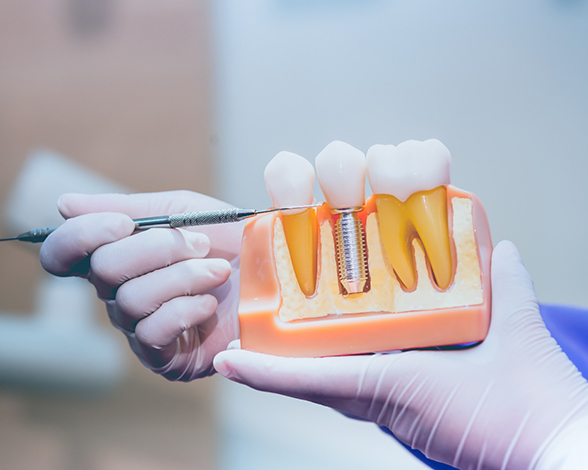
Perhaps you’re considering dental implants in Pacoima. After all, these prosthetic teeth tend to be effective and successful. However, you likely want to know more about them first. That’s only natural — you’ll be more confident about treatment if you have all the details. To that end, we at A New Smile are here to help: below are some answers to frequently asked implant questions. Feel free to look them over and learn about our restorations. If the facts you want aren’t listed, call our office to find out more!
How Long Do Dental Implants Last?
Often enough, dental implants have a lifespan of 30 years or more. They can thus last several times longer than traditional bridges or dentures. In fact, this longevity is part of what makes implants a great long-term investment.
Still, such a lifespan depends on a patient’s health and lifestyle. To make implants last, then, you must brush, floss, and rinse them daily. Furthermore, you should attend regular dental checkups and cleanings. That way, a dentist can diagnose and treat issues before the implants are at risk.
Do I Need a Bone Graft Before Getting Dental Implants?
Sometimes, a patient needs a bone graft before implant treatment. Whether you require one, though, will depend on the state of your jaw.
You see, the jawbone often atrophies when you lose teeth. Without tooth roots to stimulate it, your body will slowly dissolve its bone tissue over time. This process can then leave your jaw without the density to support implants. Should that happen, you’ll need a bone graft — a bone tissue transplant — to strengthen your jawbone to accommodate the new teeth.
Given these facts, a dentist scans your jaw prior to implant placement. Doing so lets them know whether bone grafting is needed for successful treatment.
Do Dental Implants Make You Look Younger?
Truthfully, yes — implants really do make your face look younger! (Not to mention more taut, full, and firm.)
As mentioned before, the jawbone can shrink from tooth loss — lacking teeth leaves it unable to maintain its density. This shrinkage, in turn, gives you a wrinkled, sunken-in face with lines around your mouth. Dentists often call the latter effect “facial collapse.”
Fortunately, implants can prevent facial collapse. They, unlike other restorations, can stimulate the jawbone’s various tissues. Consequently, they prevent the bone atrophy that makes you look older!
Will I Have to Take Off Work for Dental Implant Surgery?
You probably will take off work for implant surgery. Fortunately, it shouldn’t be too long —only a day or two as you get the procedure and recover afterward.
Of course, every case is different. Those with physically demanding jobs, for example, may need three or four days off. (Heavy, work-related exercise could delay your recovery.) Therefore, talk to your dentist about the days you should take off based on your unique case.
